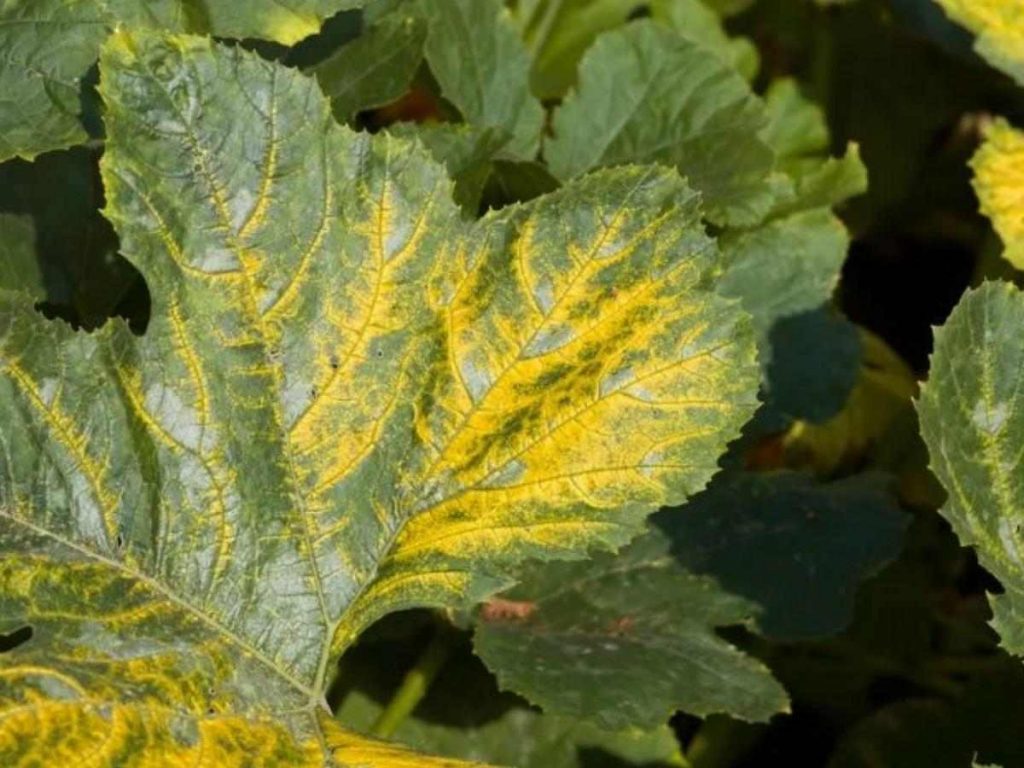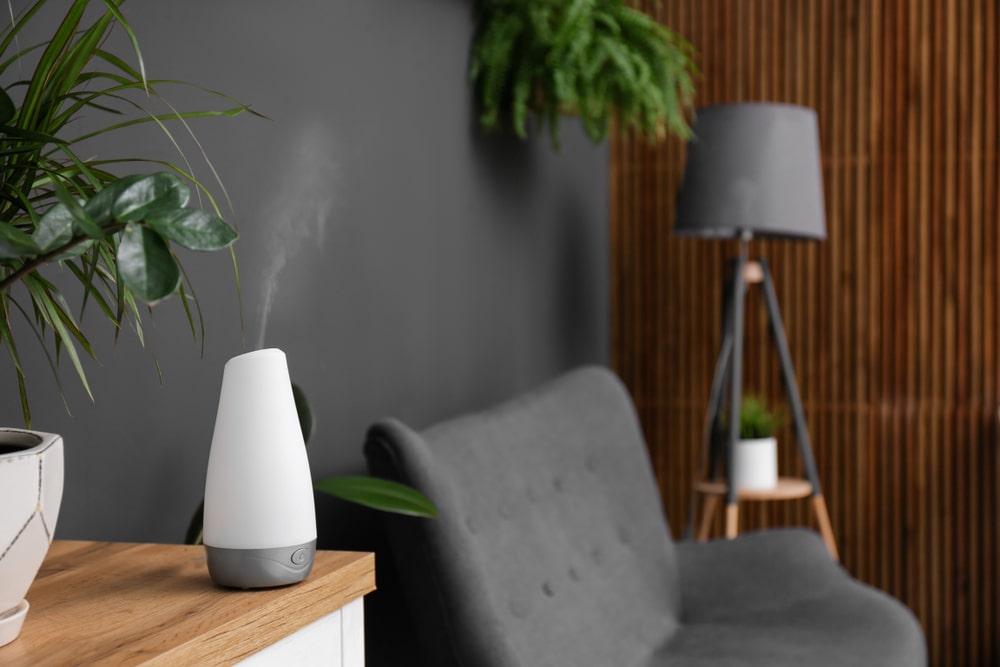Zucchini leaves are beautiful. They grow up to be a gorgeous, vibrant green. However, zucchini leaves turning yellow is the most important issue for your vegetable garden.
If you are wondering how to stop zucchini leaves from turning yellow, then this article will help!
Here’s How to Stop Zucchini Leaves Turning Yellow
There are a number of things you can do to prevent your zucchini plants from having leaves that turn yellow. Make sure the soil is rich in nutrients. You should also water them the right amount, give them full sun, remove bad pests, and invite good bugs.
These preventive measures will help keep your plants healthy and protected from damage.
We’ll come back to methods to stop zucchini leaves turning yellow, but first let’s take a look at what causes yellowing of zucchini leaves.

What causes yellowing of zucchini leaves?
Pumpkin leaves can turn yellow and start to die if you don’t fix them. Common causes are: not enough sunlight, watering problems, damaged roots, soil and nutrient deficiencies, zucchini plant diseases, pests, the right soil PH, too much clay, soil is too wet, excess phosphorous, transplant shock.
Not Enough Sunlight
Lack of sunlight could have the same negative effect on zucchini plants as it would result in the leaves not getting enough light to drive photosynthesis, which would then cause the leaves to wilt and gradually become discolored.
Exposure to direct sunlight can harm plants and cause sunburn and the scorching of leaves.
Watering Problems
Zucchini leaves may turn yellow due to too much or too little water.
When leaves on zucchini plants turn yellow or brown, it’s usually because they aren’t getting enough water.
When plants are underwater, it is difficult for them to photosynthesize, which means the leaves will turn yellow.
Overwatering may lead to the same effect. Too much water can clog the soil and prevent roots from accessing oxygen found in small pockets of air in soil.
Overwatering the soil for a long time will cause the roots to rot and leaves to turn yellow and fall off.
When the plant absorbs water from the soil, it also absorbs nutrients and minerals from the water. These nutrients help make chlorophyll in the leaves, and its deficiency causes yellowing of the foliage.
Damaged Roots
Damaged roots can cause the leaves of a zucchini plant to turn yellow. This is because the plant is unable to supply nutrients and water for healthy growth in such a case.
Soil and Nutrient Deficiencies
One of the main causes of yellowing leaves on a zucchini plant is a lack of nutrients.
If the soil is too low in iron, sulfur, or manganese, this can cause nutrient deficiencies that lead to yellowing leaves. Another problem that can occur is blossom end rot.
Zucchini Plant Diseases
Zucchini plants can develop a number of diseases, one of which is cucumber mosaic virus. This virus is spread by aphids and causes yellowing of leaves.
Fusarium wilt is another disease that can cause yellow leaves in zucchini plants. This disease is spread by cucumber beetles and affects the plant’s ability to take up water.
Downy and powdery mildew are also fungal diseases that can cause yellowing of leaves. These diseases are best treated by increasing air circulation and preventing overwatering.
Insect “Pests”
Zucchini leaves can turn yellow for a variety of reasons, but one of the most common is due to insect pests. These insects leave behind a sticky black residue that can quickly turn leaves yellow.
In addition, they often weave trails of silk that can further damage the leaves.
The Right Soil pH
The right soil pH for zucchini plants is between 5 and 7. If the pH level of your soil starts to get higher than this, the soil will become alkaline and your leaves might yellow.
Any level greater than seven shows that the soil is overly alkaline.
Your Soil Contains an Excessive Amount of Clay
Clay soil is prone to waterlogging and can cause yellowing of zucchini leaves.
Clay soil is rich in vital nutrients but lacks organic material, which hampers the plant’s ability to absorb iron.
Well-prepared soil leads to healthy zucchini plant growth. A lack of organic material will increase the water-retention capacity of clay. Waterlogged and compacted soil can cause poor root development and growth.
Your Soil Is Too Wet
If your zucchini plant is receiving too much water, the leaves may begin to turn yellow. This is due to a lack of iron absorption as overly wet soil conditions create a perfect environment for mold growth, which can lead to root rot.
Excess Phosphorous
Excess phosphorus in the soil can cause yellowing of zucchini leaves.
When a plant has too much phosphorus in the soil, it can often show signs of excess fertilizer or manure. For zucchini plants, this can manifest as leaves that start to yellow from the edges inward. Additionally, if your plants are exhibiting iron chlorosis (leaves with green veins and yellow tissue), it’s likely because they’re not able to absorb the iron they need. This problem is usually caused by an overabundance of phosphorus in the soil.
Transplant Shock
Transplant shock is when the roots of a plant are stressed from being transplanted. When you transplant your zucchini plants, they may turn yellow due to transplant shock.
Zucchini plants can be transplanted when they are fully developed or established. However, when transplanting zucchini plants, it is important to make sure the roots are not disturbed. Digging near the base of a zucchini plant can accidentally harm the roots.
Transplant shock happens if the plant is transplanted into a new container that is too small, if the plant is transplanted into new soil that is too dry or if the plant is transplanted into new soil that has different nutrients than the previous soil.
10 Simple Methods to Stop Zucchini Leaves Turning Yellow
1. Getting Enough Sunlight
You should place zucchini in a place where they will receive at least eight hours of direct sunlight, ideally six.
If you have a potted zucchini, just move it to the best spot. Place your plant in an area that receives plenty of sunlight.
2. Fixing Watering Problems
It is recommended to water in moderation. Make frequent irrigations of low intensity to prevent zucchini leaves from turning yellow.
Soils rich in organic matter or clay should be watered less frequently since they retain more water.
In contrast, watering should be very frequent and moderately intense in sandy soils that hold almost no water. If the soil is saturated, the first step is to wait for it to dry out.
3. Solve the Problem of Damaged Roots
Water the zucchini plant regularly and evenly to prevent the roots from becoming stressed and damaged.
Remove any yellow leaves that are dying to keep them from rotting and transmitting disease.
Make sure the zucchini has appropriate growing conditions, such as enough sun and water.
If the leaves are still turning yellow, try applying a nitrogen-rich fertilizer to the soil to encourage green growth.
4. Provide Enough Nutrition and Soil
Add compost to your soil to help the plant absorb the nutrients it needs.
You can also perform a soil test to determine what the ground is lacking and use fertilizers that add those deficiencies back into the garden beds.
If possible, use well-rotted horse and chicken manure to amend the soil with more nitrogen.
Avoid using cow manure to correct a nutritional shortage since it is high in phosphorus.
You can also add chelated iron to the soil if you have an iron deficiency.
5. Prevent Zucchini Plant Diseases
Crop rotation is the best way to prevent zucchini plant diseases. This involves planting zucchini in a different location each year. This prevents the build-up of disease-causing organisms in the soil.
Treat plants with best practices for fungus prevention or control and avoid overwatering to prevent fungal diseases.
Boosting air circulation helps to keep leaves dry, which reduces the chances of fungal diseases developing.
Overwatering can lead to problems such as root rot, so it is important to water only when necessary.
There are three main viruses and fungi that will cause leaves to turn yellow on your zucchini plant. These are cucurbit yellow stunting disorder virus (CYSDV), cucurbit powdery mildew (PM), and watermelon mosaic virus (WMV). Properly dispose of diseased plant matter when dealing with disease. This will help to prevent the spread of disease.
Floating row covers can prevent zucchini plant diseases. These covers provide a physical barrier between pests and plants, which can help to reduce the spread of disease. The covers also create a microclimate around the plants that is less favorable for disease development.
Downy mildew is not fatal to zucchini plants but can be cured by providing a warm, dry environment and spacing out your plants. Downy mildew is a fungal disease that affects the leaves of plants. It can cause the leaves to turn yellow and eventually die.
To stop the fungus from coming back year after year, you need a strict, long-term crop rotation plan.
Remove any diseased plants or leaves that you see and attract predatory insects to help combat downy mildew.
6. Keep Pests Away from Zucchini Plants
One way to stop zucchini leaves from turning yellow is to spray the plants down with soapy water. This will kill any pests that might be causing the problem.
You can also put on gloves and pluck pests off the plants yourself, tossing them in a bucket of soapy water to kill them.
Another way to prevent yellowing leaves is to remove the affected parts of the plant right away.
Finally, companion planting is a good way to deter pests and problems with yellowing leaves.
7. Too Much Clay? Fix It
As anyone who has attempted to dig in heavy clay knows, it can be difficult to work with. Clay soil is made up of tiny particles that pack together tightly, which can lead to waterlogging and drowned roots.
If you have too much clay in your soil, it’s important to take steps to improve the drainage. One way to do this is by adding compost, which will loosen the soil and help excess water drain away.
You may also need to water more carefully, as clay soil can require extra water.
Avoid compacting the soil when possible, and make sure it is well aerated so that roots can breathe.
With a little care, you can turn your clay soil into a garden that will thrive.
8. Solve the Problem of Too Wet Soil
If you have ever watered your plants only to find a pool of water sitting on top of the soil, this likely means that your soil has too much clay and is unable to absorb the water you are giving it. Adding organic material will help with drainage and absorption.
9. Solve the Problem of Excess Phosphorus
The problem of too much phosphorus can be fixed by using less manure and non-organic fertilizers.
Nitrogen-fixing plants can be added to help with replacing fertilizer and add nitrogen to the soil.
Compost can help with nitrogen problems and rebalance the soil.
Add chelated iron to the soil to solve the problem of excess phosphorus.
You can prevent excess phosphorus from entering the soil by watering it well and avoiding over-fertilizing.
10. Fix Transplant Shock
The best way to prevent transplant shock is to prepare for it by doing your research. Make sure that you have all the necessary medical supplies on hand in case of an emergency.
What are the symptoms of yellowing zucchini leaves?
Yellowing zucchini leaves are an indicator that your zucchini plant has an iron deficiency. Iron chlorosis is the most prevalent reason of leaves becoming yellow on zucchini plants.
Solution
The plant can be treated with an iron supplement, or it can be removed from the soil and placed in a pot with better soil.
Zucchini plants may suffer from an iron shortage, causing the leaves to become yellow. The plant can be treated with an iron supplement, or it can be removed from the soil and placed in a pot with better soil.
What Does It Mean When My Zucchini Leaves Turn Yellow?
There are a few reasons why zucchini leaves might turn yellow. One reason could be that the plant is lacking nutrients.
Another reason could be that the soil pH is off, preventing the plant from being able to absorb nutrients.
Additionally, watering problems can cause zucchini leaves to turn yellow — either the roots aren’t getting enough water, or the plant is getting too much water.
Not getting enough sunlight can also lead to yellowing leaves.
Zucchini plants can also be susceptible to diseases and pests, which can both cause yellowing of the leaves.
Finally, transplant shock—when a plant is moved from one location to another—can also cause leaves to turn yellow.
How Can You Revive a Yellowing Zucchini Plant?
If zucchini plants do start to yellow, there are a few things that can be done to revive them.
First, check for pests or diseases and remove any that are present.
Next, fertilize the plants and make sure they are getting enough sun.
Finally, if the leaves are still yellowing, they can be sprayed with a mixture of water and Epsom salt to encourage green growth.
How Do You Store Yellow Zucchini Leaves?
The best way to store yellow zucchini leaves is to keep them in a cool, dry place. If you can, try to place the zucchini plant so that it gets the most sunlight possible.
Zucchini leaves may turn yellow if they don’t receive enough water, so it’s important to check the soil often and make sure it isn’t drying out.
As always, it’s best to water on a regular schedule.
How Can You Compost Yellow Zucchini Leaves?
Adding compost or well-rotted manure to your garden can help improve the soil’s structure, which can in turn help stop zucchini leaves from turning yellow.
If your soil is too alkaline, adding compost can help bring it back into balance.
If your soil is too compacted, adding compost and other organic matter can improve its overall structure.
When dealing with diseases, make sure to get rid of the plants the right way and NEVER put diseased plant parts into your compost.
Are There Any Other Uses for Yellow Zucchini Leaves?
Some people can use yellow zucchini leaves to burn. But those uses are insignificant. So the answer is no.
What Are the Potential Risks of Using the Methods?
The risks of using the methods to stop zucchini leaves turning yellow are that it may decrease yields or even kill off immature zucchini plants.
Why Are the Edges of My Zucchini Leaves Turning Yellow?
One possible cause of the yellowing edges on zucchini leaves is poor soil moisture. This can be remedied by adding more water to the soil.
Another possible cause is too little natural rainfall. You can fix this by putting in a rain barrel or having a water meter put in.
Yet another potential cause of yellowing edges on zucchini leaves is damaged roots. Damaged roots should be removed and discarded.
Transplant shock can also cause the edges of zucchini leaves turning yellow. This is usually temporary and will resolve itself given enough time. But if the problem keeps happening, there may be diseases or pests that need to be taken care of.
Why Are the Tips of My Zucchini Turning Yellow?
One possible cause of the yellowing tips of zucchini leaves is a lack of water. If the plant is not getting enough water, the leaves will turn yellow.
Another possible cause is soil deficiency. There may not be enough calcium in the soil, which can cause the tips of the leaves to turn yellow, growth to slow down, the leaves to change shape, and the fruit to turn yellow and rot.
Should You Cut Off the Yellow Zucchini Leaves?
If you have yellow zucchini leaves, you can cut them off the plant. However, you should leave at least a few leaves on the plant so it can continue to photosynthesize and produce food for the plant.
You can also trim the leaves that are larger than the base of the plant if you want to give the plant more sun exposure.
Why Are the Bottom Leaves on My Zucchini Plant Turning Yellow?
One possible reason for the bottom leaves of a zucchini plant to turn yellow is damage to the roots. This can happen if the plant is in an area where there is a lot of foot traffic or if the soil is too compacted.
If the roots are damaged, the zucchini plants won’t be able to supply all the food and energy the plant needs to sustain good, healthy growth, and some of the leaves will start dying off.
Yellowing due to overwatering usually affects new leaves instead of older, bottom leaves.
Can You Eat Yellow Zucchini Leaves?
If you notice your zucchini plant’s leaves turning yellow, it is important to take a look at what might be causing the problem. Once you have identified the issue, you can take steps to correct it.
If the leaves are still yellow after taking corrective measures, then they are not edible.
How Can You Prevent Yellowing Zucchini Leaves?
Many of the reasons mentioned above make zucchini leaves yellow. There are some things you can do, though:
Make sure the soil is rich in nutrients: Zucchini plants need a lot of nutrients to stay healthy, so make sure the soil you’re using is rich in compost or other organic matter.
Water them the right amount: Too much or too little water can stress zucchini plants and cause their leaves to turn yellow. Water them deeply and regularly, making sure the soil is always moist but not soggy.
Practice crop rotation: Planting zucchini in the same spot year after year can lead to nutrient depletion and yellowing leaves. Practice crop rotation by planting zucchini in a different location every year.
Give them full sun: Zucchini plants need at least six hours of direct sunlight per day to thrive. If they’re not getting enough sun, their leaves will turn yellow.
Remove bad pests: Aphids, whiteflies, and cucumber beetles are all common pests that can damage zucchini plants and cause their leaves to turn yellow. Check your plants for pests often, and if you find any, get rid of them by hand or with an organic pesticide.
Invite good bugs: Good insects like ladybugs and lacewings eat bad pests like aphids and whiteflies. Attract them to your garden by planting native wildflowers or letting some of your zucchini plants go to seed.
Make sure the plants are well-managed: Zucchini plants can be susceptible to a number of diseases, so it’s important to keep them well-trimmed and free of dead leaves or flowers. Check your plants for signs of disease often and remove any leaves or stems that are affected.
Water early in the morning or at night: Watering zucchini during the heat of the day can cause the plants to wilt and their leaves to turn yellow. Water them in the early morning or evening when it’s cooler outside.
Apply a fungicide: powdery mildew is a common fungal disease that can cause zucchini leaves to turn yellow and die. If you see signs of powdery mildew, treat your plants with an organic fungicide immediately.
Use floating row coverings: Floating row coverings can protect zucchini plants from pests and diseases. Cover your plants with a row cover as soon as they’re planted and keep it in place until the end of the growing season.
Remove any infected plants or foliage: If you see any leaves or stems that are yellowing or dying, remove them from the plant immediately. These leaves can harbor diseases that can spread to other parts of the plant.
Attract predatory insects: Predators like lacewings and ladybugs eat bad pests like aphids and whiteflies. Attract them to your garden by planting native wildflowers or letting some of your zucchini plants go to seed.
Are There Any Natural Methods for Preventing Zucchini Leaves from Turning Yellow?
Indoors
Grow your plants indoors to prevent them from turning yellow. This will provide them with the ideal environment to stay healthy and avoid any potential pests or diseases.
Bright location
Move your plants to a brighter location if they are in an area that doesn’t receive enough sunlight. Zucchini plants need at least six hours of sunlight per day to prevent their leaves from turning yellow.
Feed regularly
Feed your plant regularly with a high-quality fertilizer to ensure it is getting the nutrients it needs. You need to avoid over-fertilizing as this can cause zucchini leaves to turn yellow.
Maintain soil moisture
Keep the soil well-moistened to prevent the leaves from drying out and turning yellow. Water your zucchini plants at least once a week, or more often if the weather is hot and dry. Mulch around the plants to help retain moisture in the soil.
Prune back unhealthy leaves
Prune back any unhealthy leaves that are starting to turn yellow. This will encourage new growth and help keep your plant healthy overall.







